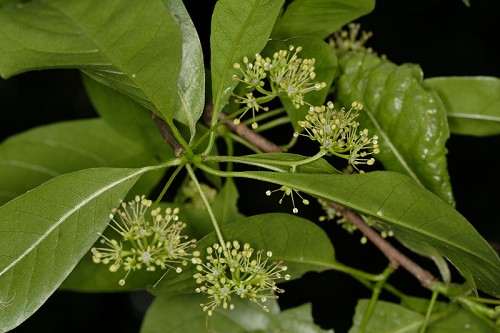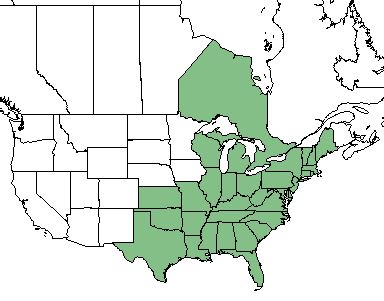Difference between revisions of "Nyssa sylvatica"
Lsandstrum (talk | contribs) |
Lsandstrum (talk | contribs) |
||
| Line 32: | Line 32: | ||
==Ecology== | ==Ecology== | ||
===Habitat=== <!--Natural communities, human disturbed habitats, topography, hydrology, soils, light, fire regime requirements for removal of competition, etc.--> | ===Habitat=== <!--Natural communities, human disturbed habitats, topography, hydrology, soils, light, fire regime requirements for removal of competition, etc.--> | ||
| − | ''N. sylvatica'' proliferates in dry or mesic upland forests, less commonly in bottomlands, pine savannas, or upland depressions, where occasionally inundated briefly. <ref name= "Weakley 2015"> Weakley, A. S. (2015). Flora of the Southern and Mid-Atlantic States. Chapel Hill, NC, University of North Carolina Herbarium. </ref> Specimens have been collected from residential areas, upland open woodland, mixed upland hardwoods, floodplain of creek, mesic wooded bluff, flatwoods, shores of lake, river floodplain, live oak stand of cypress depression, edge of small pond, slash pine flatwoods, wet hammock, cypress-gum pond, and pine woodland. <ref name = "FSU herbarium"> URL: http://herbarium.bio.fsu.edu. Last accessed: June 2018. Collectors: Loran C. Anderson, R.K. Godfrey, Angus Gholson, Wilson Baker, Patricia Elliot, A.F. Clewell, E. Tyson, E.A. Hebb, H. Kurz, Richard Mitchell, D. B. Ward, W.G. D'Arcy, C. Monk, H. Larry Stripling, Elmar Prichard, R. Komarek, R. Jean, Kevin Oakes, Cecil Slaughter, Marc Minno, T. MacClendon, K. MacClendon, Tom Gilpin, William Platt, Richard Carter, W. Baker, Sidney McDaniel, Andre Clewell, Walter S. Judd, Bob Simmons, Dana Griffin, Bruce Hansen, JoAnn Hansen, R.F. Doren, Gwynn Ramsey, E.S. FOrd, P.L Redfearn, Richard Houk, William Lindsey, R. Kral, Robert Lazor, R. A> Norris, K. Craddock Burks, K.M. Meyer. States and counties: Florida (Liberty, Leon, Walton, Suwannee, Okaloosa, Wakulla, Jefferson, Jackson, Gadsden, Columbia, Bay, Alachua, Lake, Baker, Calhoun, Osceola, Clay, Washington, Dixie, Flagler, Franklin, Madison, St. Johns, Taylor, Volusia) North Carolina (Bladen) Georgia (Grady, Thomas, Grady) Tennessee (Macon)</ref> ''N. sylvatica'' responds negatively to agricultural-based soil disturbance in South Carolina coastal plain communities. This marks it as an indicator species for remnant woodland.<ref>Brudvig, L.A., E Grman, C.W. Habeck, and J.A. Ledvina. (2013). Strong legacy of agricultural land use on soils and understory plant communities in longleaf pine woodlands. Forest Ecology and Management 310: 944-955.</ref> ''N. sylvatica'' responds positively or not at all to soil disturbance by improvement logging in Mississippi.<ref>McComb, W.C. and R.E. Noble. (1982). Response of Understory Vegetation to Improvement Cutting and Physiographic Site in Two Mid-South Forest Stands. Southern Appalachian Botanical Society 47(1):60-77.</ref> However, it does not respond to soil disturbance by clearcutting and chopping in North Florida flatwoods forests.<ref>Moore, W.H., B.F. Swindel, and W.S. Terry. (1982). Vegetative Response to Clearcutting and Chopping in a North Florida Flatwoods Forest. Journal of Range Management 35(2):214-218.</ref> ''N. sylvatica'' responds both positively and negatively to soil disturbance by roller chopping and a KG blade in East Texas Loblolly Pine-Hardwood Forests.<ref>Stransky, J.J., J.C. Huntley, and Wanda J. Risner. (1986). Net Community Production Dynamics in the Herb-Shrub Stratum of a Loblolly Pine-Hardwood Forest: Effects of CLearcutting and Site Preparation. Gen. Tech. Rep. SO-61. New Orleans, LA: U.S. Dept of Agriculture, Forest Service, Southern Forest Experiment Station. 11 p.</ref> | + | ''N. sylvatica'' proliferates in dry or mesic upland forests, less commonly in bottomlands, pine savannas, or upland depressions, where occasionally inundated briefly. <ref name= "Weakley 2015"> Weakley, A. S. (2015). Flora of the Southern and Mid-Atlantic States. Chapel Hill, NC, University of North Carolina Herbarium. </ref> Specimens have been collected from residential areas, upland open woodland, mixed upland hardwoods, floodplain of creek, mesic wooded bluff, flatwoods, shores of lake, river floodplain, live oak stand of cypress depression, edge of small pond, slash pine flatwoods, wet hammock, cypress-gum pond, and pine woodland. <ref name = "FSU herbarium"> URL: http://herbarium.bio.fsu.edu. Last accessed: June 2018. Collectors: Loran C. Anderson, R.K. Godfrey, Angus Gholson, Wilson Baker, Patricia Elliot, A.F. Clewell, E. Tyson, E.A. Hebb, H. Kurz, Richard Mitchell, D. B. Ward, W.G. D'Arcy, C. Monk, H. Larry Stripling, Elmar Prichard, R. Komarek, R. Jean, Kevin Oakes, Cecil Slaughter, Marc Minno, T. MacClendon, K. MacClendon, Tom Gilpin, William Platt, Richard Carter, W. Baker, Sidney McDaniel, Andre Clewell, Walter S. Judd, Bob Simmons, Dana Griffin, Bruce Hansen, JoAnn Hansen, R.F. Doren, Gwynn Ramsey, E.S. FOrd, P.L Redfearn, Richard Houk, William Lindsey, R. Kral, Robert Lazor, R. A> Norris, K. Craddock Burks, K.M. Meyer. States and counties: Florida (Liberty, Leon, Walton, Suwannee, Okaloosa, Wakulla, Jefferson, Jackson, Gadsden, Columbia, Bay, Alachua, Lake, Baker, Calhoun, Osceola, Clay, Washington, Dixie, Flagler, Franklin, Madison, St. Johns, Taylor, Volusia) North Carolina (Bladen) Georgia (Grady, Thomas, Grady) Tennessee (Macon)</ref> ''N. sylvatica'' responds negatively to agricultural-based soil disturbance in South Carolina coastal plain communities. This marks it as an indicator species for remnant woodland.<ref>Brudvig, L.A., E Grman, C.W. Habeck, and J.A. Ledvina. (2013). Strong legacy of agricultural land use on soils and understory plant communities in longleaf pine woodlands. Forest Ecology and Management 310: 944-955.</ref> ''N. sylvatica'' responds positively or not at all to soil disturbance by improvement logging in Mississippi.<ref>McComb, W.C. and R.E. Noble. (1982). Response of Understory Vegetation to Improvement Cutting and Physiographic Site in Two Mid-South Forest Stands. Southern Appalachian Botanical Society 47(1):60-77.</ref> However, it does not respond to soil disturbance by clearcutting and chopping in North Florida flatwoods forests.<ref>Moore, W.H., B.F. Swindel, and W.S. Terry. (1982). Vegetative Response to Clearcutting and Chopping in a North Florida Flatwoods Forest. Journal of Range Management 35(2):214-218.</ref> ''N. sylvatica'' responds both positively and negatively to soil disturbance by roller chopping and disturbance by a KG blade in East Texas Loblolly Pine-Hardwood Forests.<ref>Stransky, J.J., J.C. Huntley, and Wanda J. Risner. (1986). Net Community Production Dynamics in the Herb-Shrub Stratum of a Loblolly Pine-Hardwood Forest: Effects of CLearcutting and Site Preparation. Gen. Tech. Rep. SO-61. New Orleans, LA: U.S. Dept of Agriculture, Forest Service, Southern Forest Experiment Station. 11 p.</ref> |
===Phenology=== <!--Timing off flowering, fruiting, seed dispersal, and environmental triggers. Cite PanFlora website if appropriate: http://www.gilnelson.com/PanFlora/ --> | ===Phenology=== <!--Timing off flowering, fruiting, seed dispersal, and environmental triggers. Cite PanFlora website if appropriate: http://www.gilnelson.com/PanFlora/ --> | ||
Revision as of 19:47, 24 July 2019
Common name: blackgum [1], sour gum [2], pepperidge [2]
| Nyssa sylvatica | |
|---|---|

| |
| Photo by John Gwaltney at the Southeasten Flora Database | |
| Scientific classification | |
| Kingdom: | Plantae |
| Division: | Magnoliophyta - Flowering plants |
| Class: | Magnoliopsida - Dicots |
| Order: | Cornales |
| Family: | Cornaceae |
| Genus: | Nyssa |
| Species: | N. sylvatica |
| Binomial name | |
| Nyssa sylvatica Marshall | |

| |
| Natural range of Nyssa sylvatica from USDA NRCS Plants Database. | |
Contents
Taxonomic Notes
Synonyms: N. sylvatica var. dilatata Fernald; N. sylvatica var. caroliniana (Poiret) Fernald
Varieties: none
Description
N. sylvatica is a perennial tree of the Cornaceae family native to North America and Canada. [1]
Distribution
N. sylvatica is found in the southeastern corner of the United States from Texas to Maine, as well as the Ontario region of Canada. [1]
Ecology
Habitat
N. sylvatica proliferates in dry or mesic upland forests, less commonly in bottomlands, pine savannas, or upland depressions, where occasionally inundated briefly. [2] Specimens have been collected from residential areas, upland open woodland, mixed upland hardwoods, floodplain of creek, mesic wooded bluff, flatwoods, shores of lake, river floodplain, live oak stand of cypress depression, edge of small pond, slash pine flatwoods, wet hammock, cypress-gum pond, and pine woodland. [3] N. sylvatica responds negatively to agricultural-based soil disturbance in South Carolina coastal plain communities. This marks it as an indicator species for remnant woodland.[4] N. sylvatica responds positively or not at all to soil disturbance by improvement logging in Mississippi.[5] However, it does not respond to soil disturbance by clearcutting and chopping in North Florida flatwoods forests.[6] N. sylvatica responds both positively and negatively to soil disturbance by roller chopping and disturbance by a KG blade in East Texas Loblolly Pine-Hardwood Forests.[7]
Phenology
N. sylvatica has been observed flowering February through May. [8] It is also a relatively shade-tolerant species. [9]
Seed dispersal
This species is thought to be dispersed by consumption by vertebrates. [10]
Fire ecology
N. sylvatica is not fire resistant and has low fire tolerance. [1]
Use by animals
N. sylvatica has medium palatability tp browsing animals. [1]
Conservation and Management
Cultivation and restoration
Photo Gallery
References and notes
- ↑ 1.0 1.1 1.2 1.3 1.4 USDA Plant Database https://plants.usda.gov/core/profile?symbol=NYSY
- ↑ 2.0 2.1 2.2 Weakley, A. S. (2015). Flora of the Southern and Mid-Atlantic States. Chapel Hill, NC, University of North Carolina Herbarium.
- ↑ URL: http://herbarium.bio.fsu.edu. Last accessed: June 2018. Collectors: Loran C. Anderson, R.K. Godfrey, Angus Gholson, Wilson Baker, Patricia Elliot, A.F. Clewell, E. Tyson, E.A. Hebb, H. Kurz, Richard Mitchell, D. B. Ward, W.G. D'Arcy, C. Monk, H. Larry Stripling, Elmar Prichard, R. Komarek, R. Jean, Kevin Oakes, Cecil Slaughter, Marc Minno, T. MacClendon, K. MacClendon, Tom Gilpin, William Platt, Richard Carter, W. Baker, Sidney McDaniel, Andre Clewell, Walter S. Judd, Bob Simmons, Dana Griffin, Bruce Hansen, JoAnn Hansen, R.F. Doren, Gwynn Ramsey, E.S. FOrd, P.L Redfearn, Richard Houk, William Lindsey, R. Kral, Robert Lazor, R. A> Norris, K. Craddock Burks, K.M. Meyer. States and counties: Florida (Liberty, Leon, Walton, Suwannee, Okaloosa, Wakulla, Jefferson, Jackson, Gadsden, Columbia, Bay, Alachua, Lake, Baker, Calhoun, Osceola, Clay, Washington, Dixie, Flagler, Franklin, Madison, St. Johns, Taylor, Volusia) North Carolina (Bladen) Georgia (Grady, Thomas, Grady) Tennessee (Macon)
- ↑ Brudvig, L.A., E Grman, C.W. Habeck, and J.A. Ledvina. (2013). Strong legacy of agricultural land use on soils and understory plant communities in longleaf pine woodlands. Forest Ecology and Management 310: 944-955.
- ↑ McComb, W.C. and R.E. Noble. (1982). Response of Understory Vegetation to Improvement Cutting and Physiographic Site in Two Mid-South Forest Stands. Southern Appalachian Botanical Society 47(1):60-77.
- ↑ Moore, W.H., B.F. Swindel, and W.S. Terry. (1982). Vegetative Response to Clearcutting and Chopping in a North Florida Flatwoods Forest. Journal of Range Management 35(2):214-218.
- ↑ Stransky, J.J., J.C. Huntley, and Wanda J. Risner. (1986). Net Community Production Dynamics in the Herb-Shrub Stratum of a Loblolly Pine-Hardwood Forest: Effects of CLearcutting and Site Preparation. Gen. Tech. Rep. SO-61. New Orleans, LA: U.S. Dept of Agriculture, Forest Service, Southern Forest Experiment Station. 11 p.
- ↑ Nelson, G. PanFlora: Plant data for the eastern United States with emphasis on the Southeastern Coastal Plains, Florida, and the Florida Panhandle. www.gilnelson.com/PanFlora/ Accessed: 24 MAY 2018
- ↑ Albrecht, M. A. and B. C. McCarthy (2006). "Effects of prescribed fire and thinning on tree recruitment patterns in central hardwood forests." Forest Ecology and Management 226(1-3): 88-103.
- ↑ Kirkman, L. Katherine. Unpublished database of seed dispersal mode of plants found in Coastal Plain longleaf pine-grasslands of the Jones Ecological Research Center, Georgia.